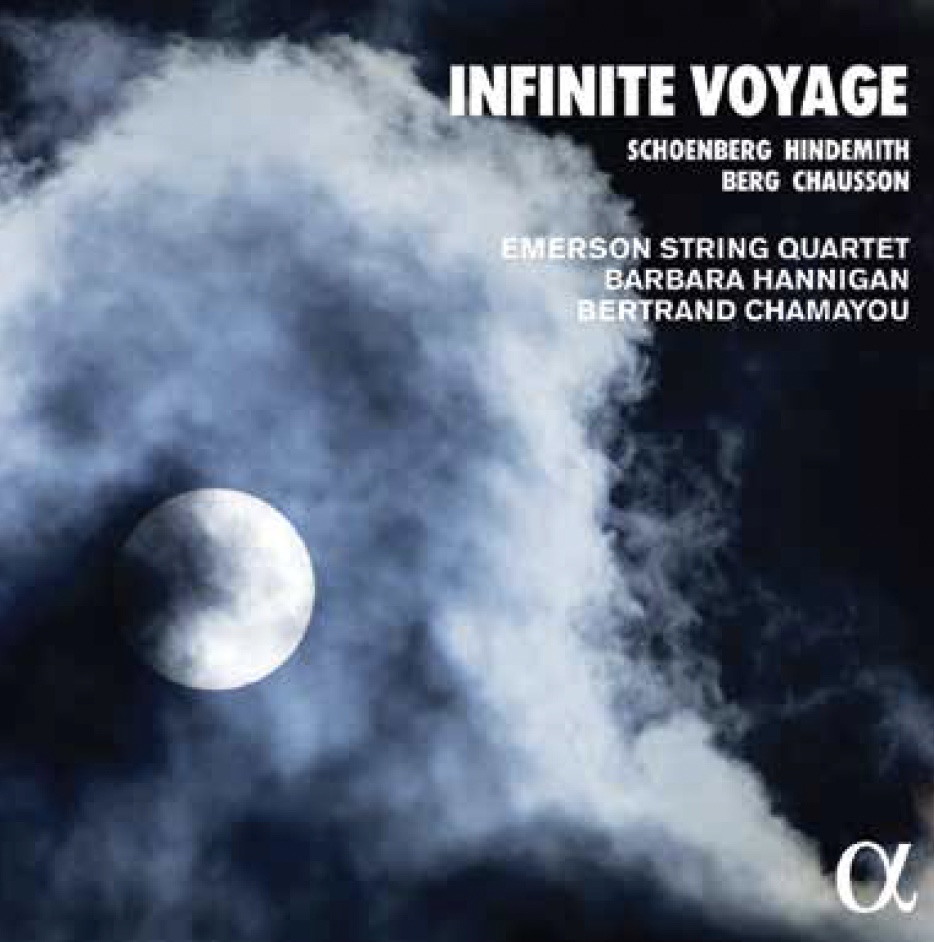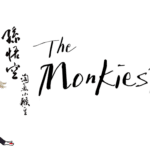SUBSCRIBE TO DIGITAL AND/OR PRINT MAGAZINE
*this text originally appeared in our
2023 winter print issue
ALPHA CLASSICS ALPHA1000
Released September 8, 2023
After 47 years of award-winning music-making, the Emerson String Quartet disbanded in October 2023; Infinite Voyage was their final release.
The origins go back some eight years to when Eugene Drucker heard Hannigan in George Benjamin’s Written on Skin and opened up a conversation about working together. The result was a concert in Berlin featuring the Schoenberg Second String Quartet; a work which is central to the new CD. That was followed up by concerts in New York, Vienna and Switzerland and the beginning of a relationship that culminates and is documented in Infinite Voyage. Although the Emerson Quartet has recorded over fifty CDs with Deutsche Grammophon this one, like most of Hannigan’s recordings, is on the Alpha Classics label.
There are four works on the CD. It begins with Hindemith’s Melancholie, Op 13. It’s a work that Reinbert de Leeuw introduced to Hannigan. It’s also new to the Emersons and a first recording of the piece for all concerned. The work is quite sparsely scored and Hannigan’s treatment of the text is interesting. She talked about “caressing” the words which, curiously, is the same word I used writing an earlier piece about her performance. Melancholie is rarely performed and even more rarely recorded. There are only two other complete versions available—so it’s a valuable addition to the catalogue.
Then comes Berg’s String Quartet Op.3. This is the one piece to feature the Emersons alone and it was recorded in a separate series of sessions in the USA rather than in the Netherlands like the other pieces on the disk. This is a piece that exemplifies the Emerson’s deep relationship with the Second Viennese School. It’s complex and astringent with rhythms and tonality that are equally demanding for players and listener.
The Chausson Chanson perpétuelle is a bit different. The tonal palette is quite distinct from the other pieces; lush and romantic rather than experimenting with the extremes of tonality, but it too has deep roots in Wagner, who perhaps would have appreciated the composer’s refusal to stretch tonality as far as the others! The ensemble here is augmented by pianist Bertrand Chamayou. And if the music is veering a bit towards sentimentality the text, about a woman contemplating suicide, maintains the rather grim tone of the other pieces.
The Schoenberg is a work that Hannigan is passionate about and it probably best exemplifies her way of working with the Emersons (or indeed any chamber ensemble). It is, of course, a seminal work said to have provoked a riot of Rite of Spring dimensions when first performed because of both its extreme abandonment of traditional tonality and the addition of a soprano soloist in the final two movements. She describes it as “really important:” and “the piece that changed everything”.
Even today this is a piece that raises all kinds of questions and provokes strong reactions. It’s not just the move away from tonality. It’s also the unusual use of a human voice in a string quartet that must have been even more shocking 100 years ago, perhaps especially when the texts are considered closely. There’s something deeply disturbing and disorienting about Stefan George’s poetry. In its way it’s as disturbing as Schoenberg’s combination of extreme atonality with snatches of popular song. Hannigan suggests that the addition of text and voice adds “emotional gravitas” and I would agree with that although I’m less sure about it “softening the blow”. To me it feels more like a double whammy. I also like her idea that performing (or listening to) the piece is like “time travelling back to Vienna”. It is, but surely it’s not the carefree Vienna of the Edwardian summer (we are talking 1908) but rather the Vienna of the increasingly bitter struggle between tradition and modernity; brilliantly analyzed by Modris Ecksteins in Rites of Spring, that would burst into inconceivable violence a few years later. Even today programming a work like this can turn the less adventurous section of the audience away.
I was curious too about how a collaboration between a string quartet and a singer works; especially when one is dealing with such strong musical personalities. What I heard was very much a partnership of equals; ”a party of five” or “a quintet of voices” with no sense of separation between the voice and the strings. Anyone who has ever watched a string quartet at work can hardly fail to notice how ’leadership’ switches, apparently seamlessly, between the players depending on where the score is going. Barbara suggests that adding a singer does not fundamentally change that dynamic.
I also wanted to know whether it was qualitatively different to work with string quartet as opposed to an orchestra or just piano. The answer I got is that ideally it’s the same kind of equal partnership but it gets harder as the forces get bigger. One can see it on some of Barbara’s video recordings with Simon Rattle conducting but I wonder how that would have gone with someone more authoritarian like, say, Karajan.
Of course there’s more to making a recording than just the performance. There’s a whole technical side to the process and it was important to Barbara that the recording took place at Muziekcentrum van de Omroep, Hilversum, where she has often recorded, and that she was working with her colleague of more than 25 years, recording engineer Guido Tichelman. Entirely unsurprisingly Barbara plays a very hands on role in the editing and selection of takes for the finished product. This one apparently involved “six days straight with Guido, together in the studio, mixing etc.” The results are impressive.
Finally there was the matter of a title. There’s something of melancholy and nostalgia about the whole project. ‘Melancholy’ infuses the music on the disk and there’s something of both in celebrating the conclusion of a productive musical friendship. There didn’t seem to be anything obvious in any of the texts though “Chanson perpétuelle” might well have been chosen. The inspiration finally came from the opening line of Stefan George’s Entrüchung which is the text of the final movement of the Schoenberg. “Ich fühle Luft von anderen Planeten” (I feel air from another planet); a sentiment that suggests a journey that may or may not have an end… Infinite Voyage.











